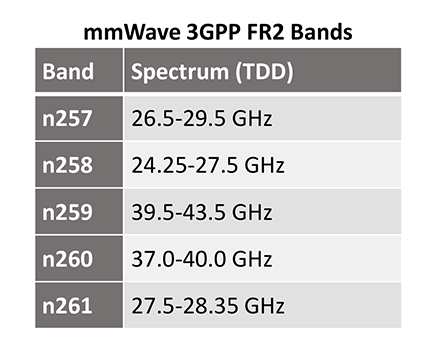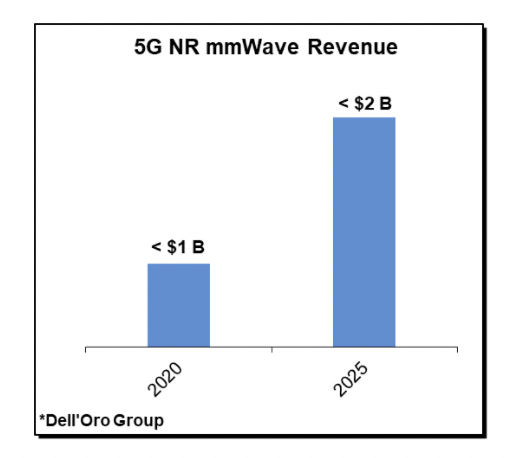Following two years of exponential growth, preliminary estimates suggest total 5G NR RAN millimeter (mmWave) revenue growth – including radio and baseband but excluding services – stabilized in the second quarter as the overall revenues were nearly flat on a year-over-year (YoY) basis, reflecting challenging comparisons in the U.S. market and slower than expected growth in the Asia Pacific (APAC) region. Still, even with the slowdown in the quarter, the outlook for mmWave 5G NR remains favorable and on track to reach $1 B to $2 B by 2025.
First and foremost, U.S. operators continue to invest in mmWave, even as the near-term focus is clearly tilted towards the sub-6 GHz spectrum. Verizon remains committed to nearly double its installed base from 17 K in 2020 to 31 K sites in 2021. And the other large U.S. carriers, including AT&T and T-Mobile, are planning to invest in mmWave where it makes sense – AT&T has said its mmWave network will be available in parts of more than 40 cities.
More importantly, activity is on the rise outside of the U.S. According to the GSA, nearly 200 operators are investing, planning, or exploring mmWave technologies. Though adoption remains uneven, the collective 5G NR mmWave installed base in Japan and South Korea is projected to approach ~0.1 M in 2022. Even if there are some risks to the downside and increasingly unlikely the Korean carriers will meet the short-term targets set out by ICT, the delays will likely be transitory.
It is no secret that the Chinese operators are focusing on the sub-6 GHz spectrum. At the same time, it will be interesting to see if mmWave will play any role at the Beijing Olympics – China Unicom has said they will deploy mmWave around the Olympic venues, though it is worth noting the suppliers are not overly optimistic about the upside here. And with mmWave licenses now becoming available in Europe (Denmark, Finland, Germany, Greece, Norway, Italy, Russia, Slovenia, Sweden, and the U.K.), operators are starting to explore how to capitalize on this incremental bandwidth across a wide range of use cases.

While outdoor is dominating the capex mix today and indoor deployments have disappointed, a string of indicators suggest future growth prospects for indoor mmWave systems are firming up with multiple suppliers – including Contela, Corning, Ericsson, Samsung, and Sercomm – offering/announcing indoor mmWave small cell systems/radios. Most of the suppliers already support 400 MHz of BW while Ericsson’s AIR 1279 supports 800 MHz of BW. Also, operators are slowly starting to deploy incremental sites indoors. AT&T, for example, plans to deploy 5G mmWave at seven airports in 2021.
Next, the suppliers are working to improve the mmWave business case, which will be key to overcome some of the technical and economic challenges associated with the higher band. mmWave repeater specialists such as Movandi and Pivotal Commware have proven that gNBs augmented with repeaters can improve the coverage and reduce the required gNB site count and the overall TCO rather substantially relative to the base case of using gNBs only.
In addition to advancements with repeater technologies, technology leaders are seeking to simplify the CPE installation process. Nokia’s recently announced 360 High Gain mmWave technology, slated for 2022, will ideally help to streamline CPE installations.
One of the more compelling aspects with the mmWave spectrum is the fact that it has potential to foster innovation across a variety of use cases. MBB is dominating now, however, FWA and industrial activity is trending upward. The limited reach with the mmWave spectrum is from an interference perspective rather compelling for enterprises. And some governments are starting to set aside spectrum for private deployments. In South Korea, for example, ICT plans to set aside 600 megahertz of mmWave spectrum in hope that bypassing the telcos can accelerate broader mmWave adoption. Japan has set aside the 28.2 GHz to 28.3 GHz for local 5G and is considering to allocate more private mmWave spectrum.
Not surprisingly, it is not all smooth sailing. Although 5G NR mmWave is maturing and uplink/downlink technology advancements are helping to improve the business case, the reality is that there is a bit of a mismatch right now when we compare cumulative mmWave RAN investments in the U.S. market as a share of total RAN and mmWave traffic as a share of total mobile traffic. Some asymmetry is expected initially in the coverage phase, before device adoption picks up. But clearly operators will weigh their options carefully – investing 2% to 5% of the capex in a technology that is addressing 0.5% to 1% (Opensignal) of the overall traffic is not always ideal.
In short, the mmWave narrative has morphed a bit since researchers suggested this would be the de-facto 5G band back in 2010. Relative to the initial expectations, mmWave has clearly underperformed. But relative to the revised expectations we outlined back in 2017, outdoor mmWave progress has surprised on the upside. With YoY growth now slowing down in the second quarter, it is tempting to question the validity again of the near-term mmWave business case. Given the current visibility, we see the slowdown more as a result of challenging comparisons than a change in the overall sentiment about the broader mmWave business case.


